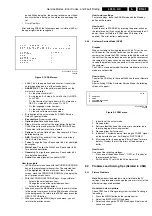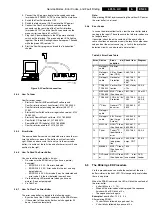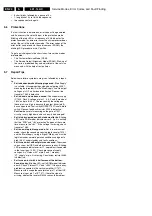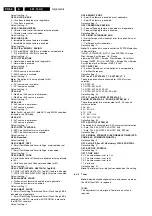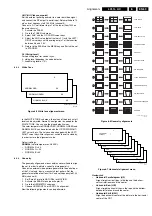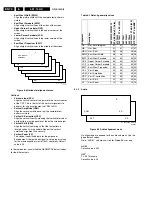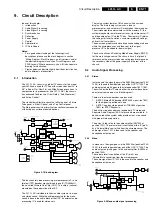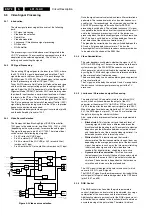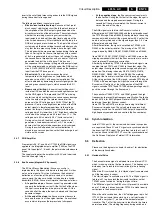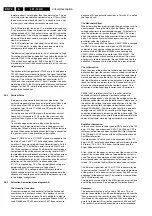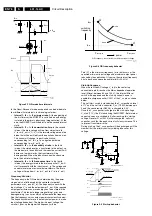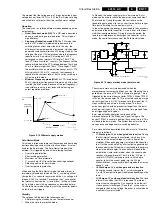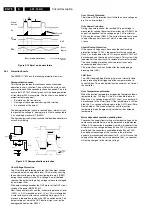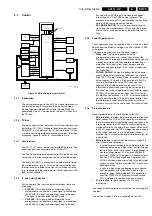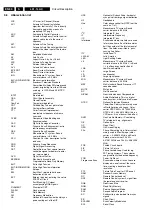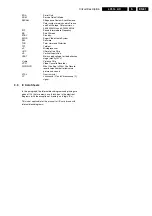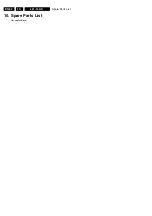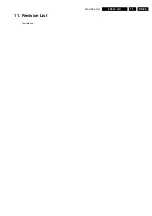
Circuit Description
9.
therefore about 2 times higher than the normal value. The 'on'
time is slowly increased to the nominal value in 1175 ms. When
the nominal value is reached, the PLL is closed in such a way
that only very small phase corrections are necessary.
The 'EHTinformation' line on pin 11 is intended to be used as a
'X-ray' protection. When this protection is activated (when the
voltage exceeds 6 V), the horizontal drive (pin 30) is switched
'off' immediately. If the 'H-drive' is stopped, pin 11 will become
low again. Now the horizontal drive is again switched on via the
slow start procedure.
The 'EHTinformation' line (Aquadag) is also fed back to the
UOC IC 7200 pin 54, to adjust the picture level in order to
compensate for changes in the beam current.
The filament voltage is monitored for 'no' or 'excessive' voltage.
This voltage is rectified by diode 6447 and fed to the emitter of
transistor 7443. If this voltage goes above 6.8 V, transistor
7443 will conduct, making the 'EHT0' line 'high'. This will
immediately switch off the horizontal drive (pin 30) via the slow
stop procedure.
The horizontal drive signal exits IC7200 at pin 30 and goes to
TS7462, the horizontal driver transistor. The signal is amplified
and coupled to the base circuit of TS7460, the horizontal output
transistor. This will drive the line output transformer (LOT)
L5445 and the associated circuit. The LOT provides the extra
high voltage (EHT), the VG2 voltage and the focus and filament
voltages for the CRT, while the line output circuit drives the
horizontal deflection coil.
9.5.2
Vertical Drive
A divider circuit performs the vertical synchronization. The
vertical ramp generator needs an external resistor (R3245, pin
20) and capacitor (C2244, pin 21). A differential output is
available at pins 16 and 17, which are DC-coupled with the
vertical output stage.
During the insertion of RGB signals, the maximum vertical
frequency is increased to 72 Hz so that the circuit can also
synchronize on signals with a higher vertical frequency like
VGA.
To avoid damage of the picture tube when the vertical
deflection fails, the guard output is fed to the beam current
limiting input. When a failure is detected, the RGB-outputs are
blanked. When no vertical deflection output stage is connected,
this guard circuit will also blank the output signals.
These '' and 'V_DRIVE-' signals are applied to the
input pins 1 and 2 of IC 7471 (full bridge vertical deflection
amplifier). These are voltage driven differential inputs. As the
driver device (IC 7200) delivers output currents, R3474 and
R3475 convert them to voltage. The differential input voltage is
compared with the voltage across measuring resistor R3471
that provides internal feedback information. The voltage across
this measuring resistor is proportional to the output current,
which is available at pins 4 and 7 where they drive the vertical
deflection coil (connector 0222) in phase opposition.
IC 7471 is supplied by +13 V. The vertical flyback voltage is
determined by an external supply voltage at pin 6
(50V). This voltage is almost totally available as
flyback voltage across the coil, this being possible due to the
absence of a coupling capacitor (which is not necessary, due
to the 'bridge' configuration).
9.5.3
Deflection Corrections (see diagram A2)
The Linearity Correction
A constant voltage on the horizontal (or line) deflection coil
should result in a sawtooth current. This however is not the
case as the resistance of the coil is not negligible. In order to
compensate for this resistance, a pre-magnetized coil L5457 is
used. R3485 and C2459 ensure that L5457 does not excite,
because of its own parasite capacitance. This L5457 is called
the 'linearity coil'.
The Mannheim Effect
When clear white lines are displayed, the high-voltage circuit is
heavily loaded. During the first half of the flyback, the high
voltage capacitors are considerable charged. At that point in
time, the deflection coil excites through C2465. This current
peak, through the high-voltage capacitor, distorts the flyback
pulse. This causes synchronization errors, causing an
oscillation under the white line.
During the second half of the flyback, C2490//2458 is charged
via R3459. At the moment of the flyback, C2490//2458 is
subjected to the negative voltage pulses of the parabola
because of which D6465 and D6466 are conducting and
C2490//2458 is switched in parallel with C2456//2457. The
high-voltage diodes are conducting this moment. Now extra
energy is available for excitation through C2465 and the line
deflection. Consequently, the flyback pulse is less distorted.
The S-Correction
Since the sides of the picture are further away from the point of
deflection than from the center, a linear sawtooth current would
result in a non-linear image being scanned (the center would
be scanned slower than the sides). For the center-horizontal
line, the difference in relation of the distances is larger then
those for the top and bottom lines. An S-shaped current will
have to be superimposed onto the sawtooth current. This
correction is called finger-length correction or S-correction.
C2456//2457 is relatively small, as a result of which the
sawtooth current will generate a parabolic voltage with
negative voltage peaks. Left and right, the voltage across the
deflection coil decreases, and the deflection will slow down; in
the center, the voltage increases and deflection is faster. The
larger the picture width, the higher the deflection current
through C2456//2457. The current also results in a parabolic
voltage across C2484//2469, resulting in the finger length
correction proportionally increasing with the picture width. The
east/west drive signal will ensure the largest picture width in the
center of the frame. Here the largest correction is applied.
East/West Correction
In this chassis, there are three types of CRTs, namely the 100
deg., 110 deg., and wide screen CRTs. The 100 deg. CRT is
raster-correction-free and does not need East/West correction.
The 110 deg. 4:3 CRT comes with East/West correction and
East/West protection.
The wide screen TV sets have all the corrections of the 110
deg. 4:3 CRT, but also have additional picture formats like the
4:3 format, 16:9, 14:9, 16:9 zoom, subtitle zoom, and the
Super-Wide picture format
A line, written at the upper- or lower side of the screen, will be
larger at the screen center when a fixed deflection current is
used. Therefore, the amplitude of the deflection current must
be increased when the spot approaches the center of the
screen. This is called the East/West or pincushion correction.
The 'Ewdrive' signal from pin 15 of IC 7200 takes care for the
correct correction. It drives FET 7400. It also corrects breathing
of the picture, due to beam current variations (the EHT varies
dependent of the beam current). This correction is derived from
the 'EHTinformation' line.
Two protections are built-in for the E/W circuit: over-current and
over-voltage protection. See paragraph 'Protection Events'.
Panorama
The panorama function is only used in 16:9 sets. This is a
function to enable the 4:3 and Super-Wide feature. It drives the
'Bass_panorama' line, to activate relay 1400. When this relay
is switched on, the capacitors 2453 and 2454 are added in
parallel to the default S-correction capacitors 2456 and 2457.
This results in an increased capacitance, a lower resonance
Summary of Contents for L01.1L AC
Page 6: ...Directions for Use EN 6 L01 1L AC 3 3 Directions for Use 3 1 16 9 Sets ...
Page 7: ...Directions for Use EN 7 L01 1L AC 3 ...
Page 8: ...Directions for Use EN 8 L01 1L AC 3 ...
Page 9: ...Directions for Use EN 9 L01 1L AC 3 ...
Page 10: ...Directions for Use EN 10 L01 1L AC 3 ...
Page 11: ...Directions for Use EN 11 L01 1L AC 3 ...
Page 12: ...Directions for Use EN 12 L01 1L AC 3 ...
Page 13: ...Directions for Use EN 13 L01 1L AC 3 ...
Page 14: ...Directions for Use EN 14 L01 1L AC 3 ...
Page 15: ...Directions for Use EN 15 L01 1L AC 3 ...
Page 16: ...Directions for Use EN 16 L01 1L AC 3 Personal Notes ...
Page 17: ...Directions for Use EN 17 L01 1L AC 3 3 2 4 3 Sets Personal Notes ...
Page 42: ...Spare Parts List EN 82 L01 1L AC 10 10 Spare Parts List Not applicable yet ...
Page 43: ...Revision List EN 83 L01 1L AC 11 11 Revision List First release ...


